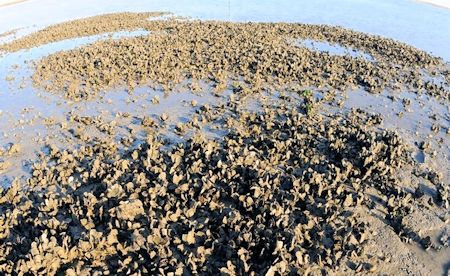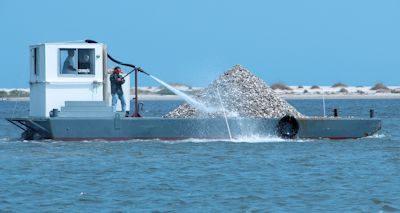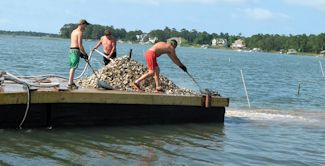 A restored oyster reef in the New River provides habitat for marine life and helps filter the water. A restored oyster reef in the New River provides habitat for marine life and helps filter the water. |
OCEAN — Much of the nitty-gritty technical talk has been talked; now it’s time to figure out how to walk the oyster walk and get things done.
The N.C. Coastal Federation and two key partners, the Albemarle-Pamlico National Estuary Partnership and the North Carolina Sea Grant, will move toward action in March with a two-day Oyster Summit that will be open to the public. It will include a legislative reception designed in part to sell the elected officials not just on the fisheries and water quality aspects of continuing to revive the state’s oyster fishery, but also on the economic benefits.
Supporter Spotlight
Set for March 10 and 11 at the N.C. Museum of Natural Sciences in Raleigh, the summit will build upon previous workshops and serve as a call-to-action.
“Last year, we really focused on some key scientific issues and got things on the table and talked about them,” said one of the organizers of the event, Erin Fleckenstein, a coastal scientist and manager of the federation’s office in Manteo. “It was mostly for restoration practitioners, state and federal agencies, scientists. It was about ideas and impediments.
“This year, it’s partly about taking those ideas and developing plans to put them into action,” she continued. “It’s also about telling the legislators and others about the economic benefits, both direct from the fishery and indirect in the form of new businesses and tourism and other economic activity.”
The public, Fleckenstein said, clearly has a role to play, both in participating in the summit and in advocacy for funding support from legislators. She wants widespread and engaged participation in the event.
Specifically, the goals are to:
Supporter Spotlight
Explore the economic and environmental returns on investing in N.C. oyster restoration, enhancement and production;
 Commercial fisherman make money by building oyster reefs in Stump Sound. |
 A state barge deposits oyster shells for a reef in Stumo Sound. |
Update the Oyster Blueprint for Action to rebuild N.C.’s oyster habitat, stocks and fisheries, and improve the state’s coastal water quality and economy;
Discuss prioritized scientific challenges to implementing successful oyster restoration strategies in North Carolina.
The summit will begin Tuesday, March 10, from 1 p.m. to 5 p.m., followed by the legislative reception. The Wednesday session will run from 8 a.m. to 4 p.m.
Tuesday’s topics include: oyster management over the past century, the importance of oysters in providing for healthy coastal ecosystems, setting restoration goals for the next decade and key challenges and questions.
Wednesday topics include: cultch planting and sanctuary goals and strategies for the next five years, watershed management and oyster mariculture goals, managing oysters on public bottoms and linking oyster restoration to economic development in coastal North Carolina.
That last topic is a big part of the reason organizers hope for a healthy turnout by the legislators at the reception. All have been invited as has Gov. Pat McCrory. The two-day session is in part a sales job, intended to get decision-makers to buy into the idea that restoring the coast’s oyster beds could be good for the region’s economy.
Part of the idea, Fleckenstein said, is to show that there are roles and benefits for a diverse group of actors in the big effort, both public and private. “We want to set out a way to move forward, to improve water quality, the harvest and the economy,” she said. “We’re hoping that as we move on, we’ll be able to identify sources of investment, some from government and some private. The state has made some good commitments in the past and we’d like to find ways to continue those and to get more.”
One example she cited from the 2014 legislature was the idea of creating a large oyster sanctuary, up to 10,000 acres, named for longtime Carteret County legislator Jean Preston, in Pamlico Sound. The idea generally was favorably received, but was shelved for study, and the federation, while not asking that it be funded yet, would like to see it and ideas like it seriously discussed.
Fleckenstein said she thinks that a good contingent of legislators will show up for the conference and that the message of the oyster as economic engine and environmental benefactor is one everyone can get behind.
The legislative reception will be from 5:30 p.m. to 7:00 p.m. on March 10 and will feature a talk by Rowan Jacobsen, author of A Geography of Oysters, which won the James Beard Award. He writes about food, the environment and the intersection of the two. His work has appeared in The New York Times, Outside, Harper’s and Eating Well.
At the reception, the public will get the chance to meet legislators, sample N.C. oysters and enjoy a cash bar.
 Contractors shovel shells for an oyster reef in the Lockwood Folly River. Photo: Tess Malijenovsky |
All of this comes at a key time for the future of the oyster fishery, but it’s clear, Fleckenstein noted, that efforts in recent years by the state and by other public and private entities, including the federation, have already made a difference.
In fact, as little as 20 years ago, the state’s commercial harvest almost disappeared, devastated by habitat loss, pollution and Dermo, a parasitic disease that kills the shellfish before they reach the legal harvest limit. In 1994, the state’s watermen harvested a paltry 34,727 bushels of oysters, worth a meager $632,000, according to state Division of Marine Fisheries figures.
As oyster and fish houses continued to shut down and fisheries managers contemplated drastic measures, such as bringing in and planting non-native oysters in the state’s coastal waters, an industry that once supported thousands of fishermen and their families seemed headed for a technical knockout.
But thanks to concerted efforts – planting of shells by the fisheries division to create and help rebuild reefs and construction of new ones, large and small, by the federation and other groups and individuals – the fishery has come back, reaching 196,661 bushels in 2010 and 151,314 in 2011 before dropping to 83,188 in 2012. It rebounded strongly in 2013, however, back up to 110,892 bushels worth $3.4 million to the economy.
Oysters can live up to 40 years and grow up to 8 inches. However, most N.C. oysters are harvested at three years of age, at the minimum harvest size of three inches. In the early stages of an oyster’s life, it’s carried about by currents. As it matures, the oyster sinks to the bottom, and to survive, it must land on a hard surface. That’s why they are found growing together in clumps.
Experts say each adult oyster filters and cleans up to 50 gallons of water a day, eating algae and removing sediments and nitrogen. So it’s easy to see why a good oyster population makes a big difference in local water quality, as well as the quality in a larger system.
“Oysters really are a win-win-win,” for the environment, the economy and the public’s use of coastal waters,” Fleckenstein said. “This is a great opportunity for the public to get involved and help us move forward.”
Early-bird summit registration for $35 per person is under way and closes on Feb. 10. Regular registration for $45 continues through Feb. 27. Registration fees are payable on the federation website.
A block of rooms has been reserved through the N.C. Coastal Federation at the Holiday Inn in downtown Raleigh, 320 Hillsborough St., at a special rate of $79 a night. Hotel reservations must be made by Feb. 16.







